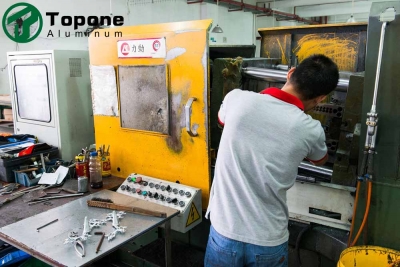In die casting production, different alloy materials can be manufactured into corresponding blank products by different processes and machines (such as zinc alloy die castings, aluminum alloy die castings, magnesium alloy gold die castings). And then surface processing can become a product that consumers can use. Among them, aluminum alloy die-casting electroplating is a common surface treatment process, but it is more complex than zinc alloy die-casting electroplating process, high requirements, Topone Metalwork today on this issue to talk about the relevant technical points, to avoid unnecessary problems in the process of electroplating.
1. reduce defects in aluminum alloy die castings
Simply put, it is necessary to avoid surface defects (such as surface sand hole, shrinkage, cold lines, corrosion mold, blanking etc.) caused by inappropriate die-casting mold, die-casting environment (cooling system, pressure system, etc.), die-casting machine, manual operation methods and so on in the production process of aluminum die-casting, and further affect the aluminum alloy die-casting. The rate of defective plating increased.
2. avoid surface polishing improper handling defects.
Surface polishing is the primary process for aluminum alloy die casting before electroplating, and it is also very important. Polishing is to remove some defects on the surface of the black embryo casting, and achieve the goal of surface smoothness and smoothness, so as to make the subsequent electroplating easier. However, this process should avoid artificial shortcomings, such as deformation, size changes, quality control should be strict.
3. avoid the incomplete cleaning before plating, resulting in quality problems after plating.
Before electroplating, aluminum alloy die castings need to be cleaned by ultrasonic wave to remove wax and oil so as to achieve surface cleanliness and ensure the reliability of subsequent electroplating. This process should be carried out strictly in accordance with the operation instructions, and the time, temperature and acoustic parameters should be set in accordance with the process requirements.
4. avoid poor adhesion and produce defective products.
The adhesion of alloy products can be detected by a rigorous 100 gram test to know whether the electrodeposits are firm. However, because the surface activity of aluminum alloy is not as high as that of zinc alloy, the adhesion of aluminum alloy die castings after electroplating is not so easy to control. The industry's general solution is to pre-plating before the formal plating, that is, surface passivation and copper substrate, and then formal plating, this scheme has been recognized by the industry.
In a word, in the electroplating process of aluminum alloy die castings, even if the materials of die castings are the same, there will be differences in the process of electroplating because of the different operation methods. In order to ensure the quality of the final surface treated products, it is necessary to calmly analyze and find the appropriate solution to reduce the rate of defect in production.

